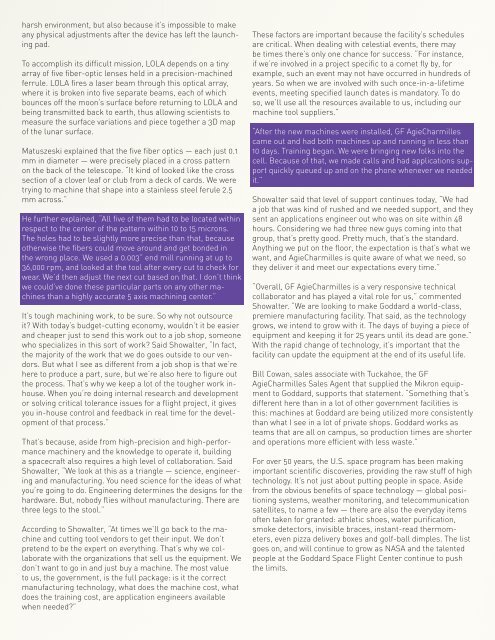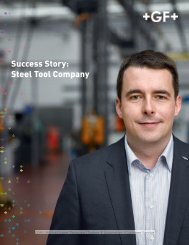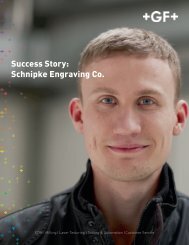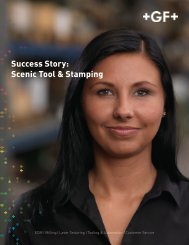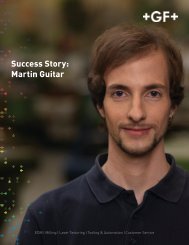NASA Goddard
Create successful ePaper yourself
Turn your PDF publications into a flip-book with our unique Google optimized e-Paper software.
harsh environment, but also because it’s impossible to make<br />
any physical adjustments after the device has left the launching<br />
pad.<br />
To accomplish its difficult mission, LOLA depends on a tiny<br />
array of five fiber-optic lenses held in a precision-machined<br />
ferrule. LOLA fires a laser beam through this optical array,<br />
where it is broken into five separate beams, each of which<br />
bounces off the moon’s surface before returning to LOLA and<br />
being transmitted back to earth, thus allowing scientists to<br />
measure the surface variations and piece together a 3D map<br />
of the lunar surface.<br />
Matuszeski explained that the five fiber optics — each just 0.1<br />
mm in diameter — were precisely placed in a cross pattern<br />
on the back of the telescope. “It kind of looked like the cross<br />
section of a clover leaf or club from a deck of cards. We were<br />
trying to machine that shape into a stainless steel ferule 2.5<br />
mm across.”<br />
He further explained, “All five of them had to be located within<br />
respect to the center of the pattern within 10 to 15 microns.<br />
The holes had to be slightly more precise than that, because<br />
otherwise the fibers could move around and get bonded in<br />
the wrong place. We used a 0.003” end mill running at up to<br />
36,000 rpm, and looked at the tool after every cut to check for<br />
wear. We’d then adjust the next cut based on that. I don’t think<br />
we could’ve done these particular parts on any other machines<br />
than a highly accurate 5 axis machining center.”<br />
It’s tough machining work, to be sure. So why not outsource<br />
it? With today’s budget-cutting economy, wouldn’t it be easier<br />
and cheaper just to send this work out to a job shop, someone<br />
who specializes in this sort of work? Said Showalter, “In fact,<br />
the majority of the work that we do goes outside to our vendors.<br />
But what I see as different from a job shop is that we’re<br />
here to produce a part, sure, but we’re also here to figure out<br />
the process. That’s why we keep a lot of the tougher work inhouse.<br />
When you’re doing internal research and development<br />
or solving critical tolerance issues for a flight project, it gives<br />
you in-house control and feedback in real time for the development<br />
of that process.”<br />
That’s because, aside from high-precision and high-performance<br />
machinery and the knowledge to operate it, building<br />
a spacecraft also requires a high level of collaboration. Said<br />
Showalter, “We look at this as a triangle — science, engineering<br />
and manufacturing. You need science for the ideas of what<br />
you’re going to do. Engineering determines the designs for the<br />
hardware. But, nobody flies without manufacturing. There are<br />
three legs to the stool.”<br />
According to Showalter, “At times we’ll go back to the machine<br />
and cutting tool vendors to get their input. We don’t<br />
pretend to be the expert on everything. That’s why we collaborate<br />
with the organizations that sell us the equipment. We<br />
don’t want to go in and just buy a machine. The most value<br />
to us, the government, is the full package: is it the correct<br />
manufacturing technology, what does the machine cost, what<br />
does the training cost, are application engineers available<br />
when needed?”<br />
These factors are important because the facility’s schedules<br />
are critical. When dealing with celestial events, there may<br />
be times there’s only one chance for success. “For instance,<br />
if we’re involved in a project specific to a comet fly by, for<br />
example, such an event may not have occurred in hundreds of<br />
years. So when we are involved with such once-in-a-lifetime<br />
events, meeting specified launch dates is mandatory. To do<br />
so, we’ll use all the resources available to us, including our<br />
machine tool suppliers.”<br />
“After the new machines were installed, GF AgieCharmilles<br />
came out and had both machines up and running in less than<br />
10 days. Training began. We were bringing new folks into the<br />
cell. Because of that, we made calls and had applications support<br />
quickly queued up and on the phone whenever we needed<br />
it.”<br />
Showalter said that level of support continues today, “We had<br />
a job that was kind of rushed and we needed support, and they<br />
sent an applications engineer out who was on site within 48<br />
hours. Considering we had three new guys coming into that<br />
group, that’s pretty good. Pretty much, that’s the standard.<br />
Anything we put on the floor, the expectation is that’s what we<br />
want, and AgieCharmilles is quite aware of what we need, so<br />
they deliver it and meet our expectations every time.”<br />
“Overall, GF AgieCharmilles is a very responsive technical<br />
collaborator and has played a vital role for us,” commented<br />
Showalter. “We are looking to make <strong>Goddard</strong> a world-class,<br />
premiere manufacturing facility. That said, as the technology<br />
grows, we intend to grow with it. The days of buying a piece of<br />
equipment and keeping it for 25 years until its dead are gone.”<br />
With the rapid change of technology, it’s important that the<br />
facility can update the equipment at the end of its useful life.<br />
Bill Cowan, sales associate with Tuckahoe, the GF<br />
AgieCharmilles Sales Agent that supplied the Mikron equipment<br />
to <strong>Goddard</strong>, supports that statement. “Something that’s<br />
different here than in a lot of other government facilities is<br />
this: machines at <strong>Goddard</strong> are being utilized more consistently<br />
than what I see in a lot of private shops. <strong>Goddard</strong> works as<br />
teams that are all on campus, so production times are shorter<br />
and operations more efficient with less waste.”<br />
For over 50 years, the U.S. space program has been making<br />
important scientific discoveries, providing the raw stuff of high<br />
technology. It’s not just about putting people in space. Aside<br />
from the obvious benefits of space technology — global positioning<br />
systems, weather monitoring, and telecommunication<br />
satellites, to name a few — there are also the everyday items<br />
often taken for granted: athletic shoes, water purification,<br />
smoke detectors, invisible braces, instant-read thermometers,<br />
even pizza delivery boxes and golf-ball dimples. The list<br />
goes on, and will continue to grow as <strong>NASA</strong> and the talented<br />
people at the <strong>Goddard</strong> Space Flight Center continue to push<br />
the limits.


